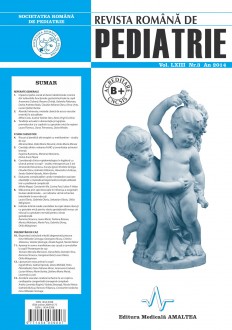SELECT ISSUE

Indexed

| |

|
|
|
| |
|
|
|

|
|
|
|
|
|
|
HIGHLIGHTS
National Awards “Science and Research”
NEW! RJP has announced the annually National Award for "Science and Research" for the best scientific articles published throughout the year in the official journal.
Read the Recommendations for the Conduct, Reporting, Editing, and Publication of Scholarly work in Medical Journals.
The published medical research literature is a global public good. Medical journal editors have a social responsibility to promote global health by publishing, whenever possible, research that furthers health worldwide.
MASURAREA PRIN SPECTROSCOPIE IN INFRAROSU A OXIGENARII TISULARE ABDOMINALE – UN INDICATOR UTIL AL ISCHEMIEI INTESTINALE LA NOU-NASCUTI
Laura Olariu, Gabriela Olariu, Sebastian Olariu and Otilia Marginean
ABSTRACT
Introducere. Ischemia intestinală neonatală este o patologie frecventă, dar din păcate, de multe ori subdiagnosticată. Tehnica actuală permite investigarea non-invazivă a circulaţiei la nivel splahnic, putând decela precoce modificările de perfuzie-oxigenare care apar la acest nivel.
Obiective. Scopul acestui studiu a fost de a determina valoarea clinică a spectroscopiei în infraroşu (NIRS) în detectarea precoce a modificărilor ischemice intestinale la nou-născuţii din secţia de Terapie Intensivă Neonatală.
Material şi metodă. Am efectuat un studiu prospectiv observaţional pe o perioadă de 18 luni, pe un lot de 15 nou-născuţi cu vârsta de gestaţie între 25-38 săptămâni. Toţi nou-născuţii luaţi în studiu au prezentat unul sau mai multe semne clinice de patologie digestivă. Începerea monitorizării non-invazive continue prin NIRS cerebrală şi abdominală s-a efectuat în momentul apariţiei primelor modificări digestive, între ziua 3-21 de viaţă. A fost măsurată saturaţia oxigenului la nivel cerebral şi abdominal (rSO2 -C şi rSO2 -A) şi s-a efectuat raportul oxigenării cerebro-splahnice (ROCS). În paralel nou-născuţii au fost monitorizaţi complex prin metode biologice şi paraclinice. Perioada de monitorizare a fost variabilă, fiind cuprinsă între 1-5 zile, perioadă necesară în stabilirea diagnosticului cauzal, şi apoi mai departe pentru urmărirea în dinamică a modificărilor perfuziei intestinale sub tratamentul instituit. Semnificaţia statistică a fost determinată folosind testul statistic t, calculând „p“ pentru un interval de încredere de 95% (semnificaţie statistică p < 0,05). De asemenea, a fost evaluată curba ROC pentru a determina capacitatea acestei tehnici de a fi un instrument de diagnostic.
Rezultate. Lotul de copii luaţi în studiu a inclus: 3 nou-născuţi cu malformaţie cardiacă congenitală (MCC) cu scăderea importantă a fluxului sanguin în aortă, 4 nou-născuţi cu enterocolită ulcero-necrotică (EUN) stadiul II, 3 pacienţi cu retard de creştere intrauterină (RCIU) formă severă, 1 nou-născut cu atrezie intestinală şi peritonită secundară, 1 nou-născut cu anemie prin incompatibilitate Rh cu anasarcă feto-placentară şi 3 pacienţi cu sepsis şi patologie digestivă asociată dar fără criterii de EUN. La toţi pacienţii valorile măsurătorilor NİRS au fost semnificativ scăzute faţă de valoarea normală, cu valori diferite în funcţie de severitatea afecţiunii. Valoarea medie a rSO2 -A a fost de 41,85 (interval de variaţie 15-85) faţă de o valoare medie considerată normală. De asemenea, valoarea medie a raportului ROCS a fost semnificativ scăzută faţă de valoarea normală. Cele mai mici valori ale rSO2 -A la începutul simptomatologiei le-a avut grupul de pacienţi cu MCC urmaţi de cei cu EUN. Aria de sub curba ROC a fost 0,95 (95% CI 0,88-1,02) pentru raportul ROCS. Considerând o valoare limită a ROCS pentru predicţia ischemiei intestinale de < 0,75, acest raport se dovedeşte a fi un indicator excelent al modificărilor circulaţiei intestinale.
Concluzii. Metoda NIRS are potenţialul de a detecta apariţia alterărilor în oxigenarea şi perfuzia intestinală, permiţând detectarea precoce a ischemiei intestinale, chiar înainte de modificarea altor parametri hemodinamici. NIRS este o metodă bună, non-invazivă, de urmărire în dinamică a modificărilor perfuziei tisulare sub tratamentul instituit, fiind de asemenea capabilă să ghideze tratamentul, având un real folos în practica clinică.
Cuvinte cheie: spectroscopie în infraroşu, nou-născuţi, saturaţia regională în oxigen, ischemie intestinală
